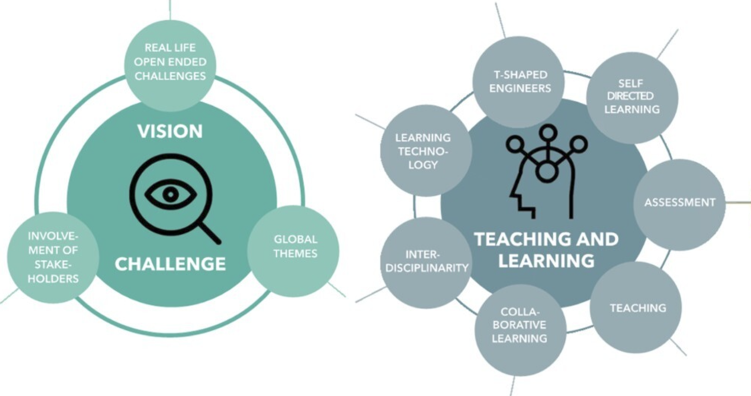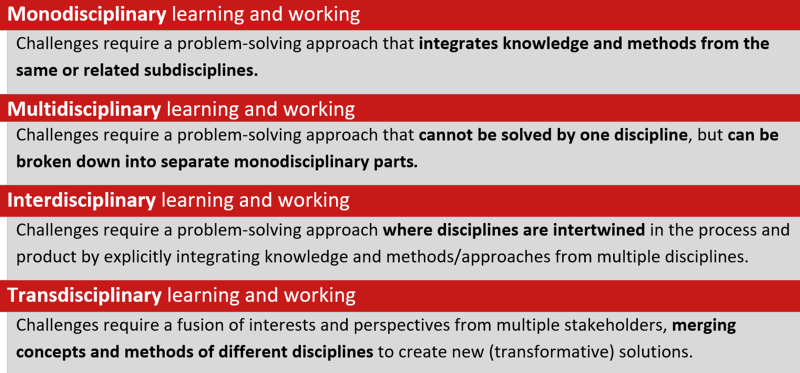10 Dimensions of CBL
TU/e has proposed a set of dimensions and indicators to provide a structured framework for understanding and implementing CBL effectively. The dimensions and their indicators provide a roadmap for educators to design, implement and evaluate Challenge-Based Learning in a way that aligns with its core principles.

Real-life Open Ended Challenges
A CBL course uses authentic, open-ended challenges as a starting point for learning. These challenges do not have a single predefined problem, process or solution, so students learn to define and address their own problem. Besides solving these problems, students learn what it takes to work towards a solution. This requires critical thinking, collaboration and a synthesis of different perspectives in order to define the problem to be tackled. An interdisciplinary approach is also needed in order to explore multiple solutions.
Global Themas
Preferably, challenges in CBL are connected to themes of global importance, such as sustainability or specific SDGs. In this respect, CBL focuses on technology and on societal impact. By addressing the connection to these global themes, students develop the mindset of engineers of the future.
Involvement of Stakeholders
Stakeholders bringing real-world expertise to the educational experience. They mostly work in industry, society or science. Their involvement ensures that the challenges presented to students are rooted in actual scientific, societal or industry needs. By collaborating with stakeholders, educators can bridge the gap between academic learning and real-world application, making the CBL experience more authentic and meaningful for students.
T-Shaped Engineers
At TU/e, Challenge-Based Learning is aimed at developing T-shaped engineers. CBL challenges educators to present challenges and learning activities that require the acquisition, integration and application of in-depth disciplinary knowledge. In addition, CBL links this to professional and personal competences that enable engineers to apply this knowledge and to work with a wide range of people and situations.
Self-Directed Learning
The open-ended nature of CBL requires students to take the lead and shape their own engineering profile. CBL stimulates students to become self-directed learners by formulating their own learning goals, choose resources, determine learning strategies and evaluate outcomes. Suitable support and guidance is needed for students to develop their self-directed learning skills.
Assessment
In CBL, assessment requires a good balance between the product and the process, the team and the individual, and formative and summative moments. This means evaluating not just the solutions that students come up with but also their approaches and learning processes. For CBL, assessment should be a mix of evaluation formats and feedback methods supporting students in their continuous learning process.
Teaching
The learning needs of students are highly diverse. That's why it is ideally a team effort involving many roles. Tasks include:
- designing challenges that stimulate learning;
- supporting and assessing students in acquiring the right knowledge and skills and
- having contact with stakeholders.
Forming cross-functional teams combining different roles and expertise can help to achieve this.
Collaborative Learning
In CBL courses, collaborative learning plays an important role in regulating the working and learning process. It's not just about working together but about leveraging the diverse skills, knowledge and perspectives of each group member to achieve better outcomes than one could achieve individually. The collaborative nature of CBL ensures that students learn the subject matter and acquire essential skills to become a T-shaped professional.
Interdisciplinarity
In order to find a solution to modern societal challenges, CBL ideally requires a synthesis of different perspectives, knowledge and fields of expertise. In a CBL curriculum line, courses can vary in the complexity of disciplinary learning.

Learning Technology
Technology refers to the tools, outcomes and resources used in CBL. In CBL, technology-rich learning and working environments are used to support the learning aspects of CBL, such as active learning, deep learning, social learning and data-driven learning. The goal is not only to facilitate learning and teaching; it also concerns the teamwork and outcomes that use technology-rich solutions.